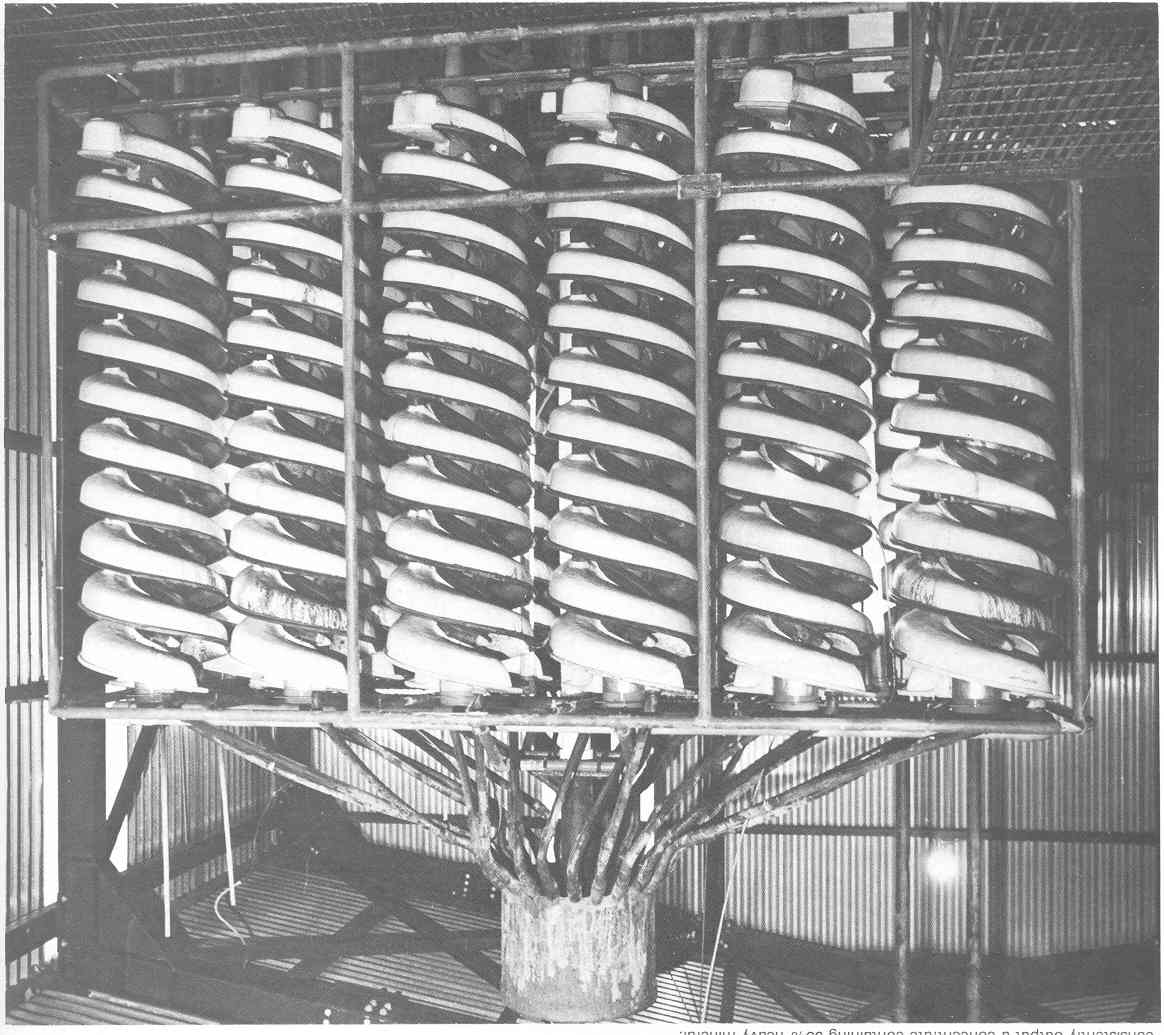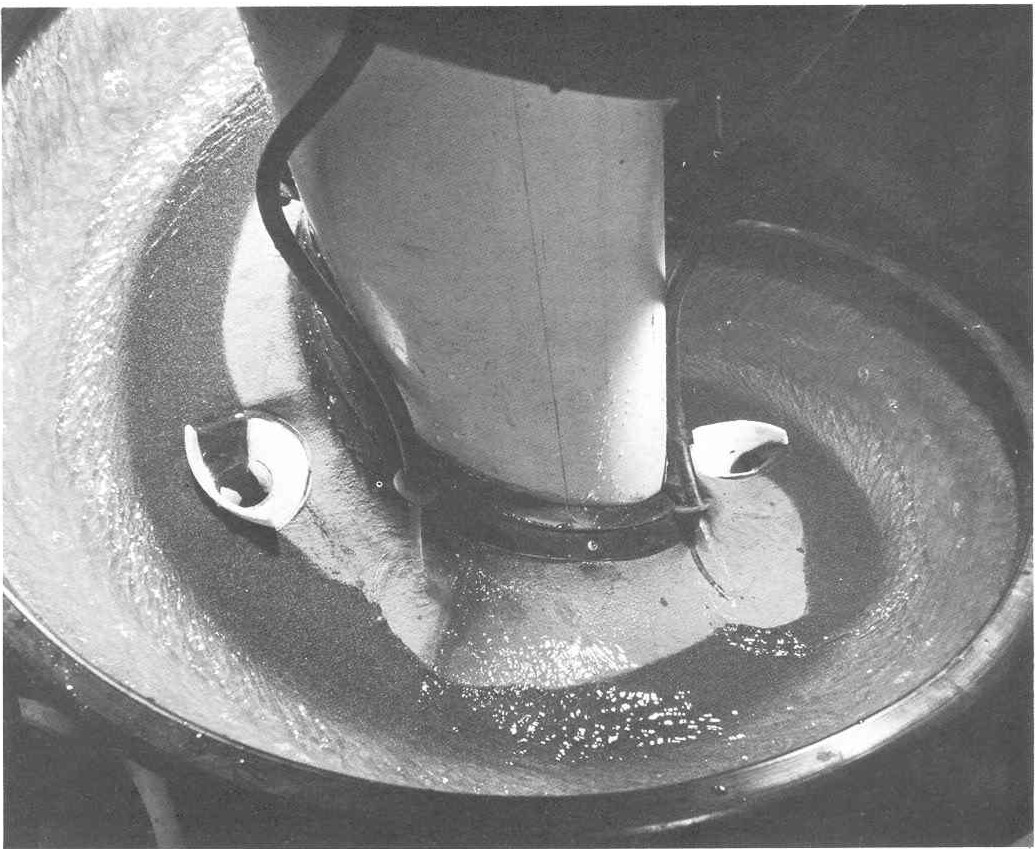Gravity Concentration 7
The Reichert Cone is terrific if you have enough material to process with enough fine gold to make it profitable.
Otherwise other machines can give similar recoveries at small ton rates.
Spirals:



triple start spiral.
These machines use bed lag to work. A flow of material if fed to the top of the spiral and the heavy minerals lag behind the lighter materials ( dense materials always occupy the zone of lowest energy ). This lag causes the heavies to flow along the inside of the bend. The flow is then separated by cutters at the bottom, very much like cones.
Sluices:
This mimicking of a streambed is still the most common method used. Sluice boxes are just an approximation of a stream channel to try and make operation and cleanup easier than digging around.
The most important part of a sluice box is having a place where the gold can be concentrated and collected. The bottom of the sluice is where the gold will settle, and even though gold is of such a high density that wants to stay on the bottom more than any other mineral, it can and will be washed out of the sluice.
Riffles are the most common method of creating pockets on the bottom of the sluice. These pockets are zones of reduced energy where minerals may settle, and are designed to retain the gold once captured. They may be designed from a multitude of materials, layers and shapes, all varied due to individual taste and superstition.
High specific gravity minerals such as gold will generally concentrate on any surface. Gold will concentrate on a slick sheet of steel as long as the flow velocity is not too high.
You may make riffles out of any material, sheepskins, rocks, cloth, wood, steel, horsehair,,, anything will do. It is just that some materials are better for wear, shape, and size. To get a sluice maximized for concentration it is good to generate high shear zones and deep enough pockets to avoid scour, so shape is where most fiddling takes place. In general riffles made of angle iron or expanded metal are the most used.
Sluices are cheap to operate. This is why they are used so often. The capital cost of building the sluice is cheap, and pumping water is also very cheap. The recovery is lousy but most people do not really care and never test the tails. If they did test the tails with another sluice then the results they would get are useless, as that sluice looses lots also and the gold in the tails is the tough stuff to recover.
A sluice can have very high recoveries. Close to 100% in the first minute of operation as the riffles are filling up with new material, and reducing quickly thereafter. Few sluices get over 50% recovery of the minus 100 mesh fraction in general operation.
There are several reasons for the loss of gold in a sluice.
1: entrained air in the sluice floating gold.
2: oil in the slurry, making it easier for the gold to float.
3: high velocities in the fluid flow of the sluice causing the gold to be carried by flow out of the sluice, either too steep a gradient, or too much water.
4: clay in the feed not being puddled properly, carrying the gold out of the sluice
5: large rocks not being properly washed. The best pans I have ever had were from scraping large rocks.
6: whitewatering a sluice, allowing air to float the gold out of the sluice.
7: sluice too short. EVERY foot of a sluice WILL pay for itself, even sluices 2 miles long. That 6 foot sluice looses a lot of gold.
8: riffles packing tight making the riffles useless. This is why it is important to never run a sluice for over one shift before cleanup.
9: slugging the sluice. Large fluctuations in slurry flow, allowing slugs of material to travel the sluice without being washed.
10: allowing large rocks to sit in the sluice, scouring the riffles.
If you are in a placer that for some reason has no gold smaller than a grain of rice, then it is a good idea to use a sluice, you will have 99% recoveries. I am sure that there may be at least one placer like this in the world.
The sluice will never be a good concentration device for small particle sizes, there are too many conflicting needs. Foremost of which is the need for high velocities to move the slurry and to keep the riffles loose and stirred.
You may play around with any feature you want with the sluice, and many have, it will ALWAYS be inadequate in most if not all circumstances.
